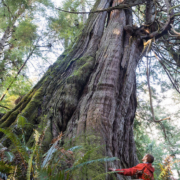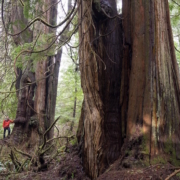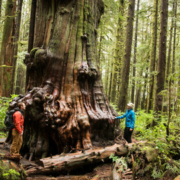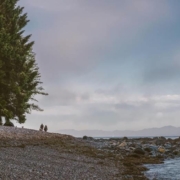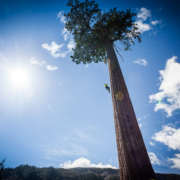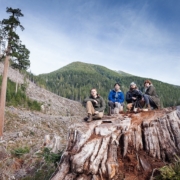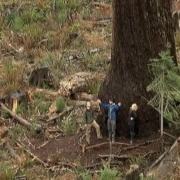Avatar Grove, the sequel: Introducing Jurassic Grove
Towering more than 30 metres high, an ancient red cedar’s heavy branches fork skyward above massive burls dusted in moss.
The 500- to 1,000-year-old tree is at the centre of what the Ancient Forest Alliance says is an exciting find — an old-growth stand between Jordan River and Port Renfrew that could become the region’s next attraction.
“The whole area is a lowlands, spectacular ancient forest,” said Ken Wu, executive director of the Ancient Forest Alliance.
Jurassic Grove, as the group is calling it, covers an area of about 130 hectares near the mid-section of the Juan de Fuca Trail, between Lines Creek and Loss Creek. It’s about a 90-minute drive from Victoria and 20 minutes from Port Renfrew.
While most of the trees are protected as part of a marbled murrelet wildlife habitat area, about 40 hectares are vulnerable to logging on unprotected Crown lands.
There are no approved logging plans for the area, but that could change at any moment, Wu said.
“Virtually everywhere we find a grove like this, fairly soon it is flagged for logging,” he said.
Wu said the Ancient Forest Alliance isn’t the first to discover the area, which lies in the traditional Pacheedaht territory and has likely been a destination for mushroom hunters and other forest fans.
But it identified the area as a potential conservation zone by studying aerial maps and exploring off trails.
As a self-described “big-tree hunter,” co-founder T.J. Watt’s first clue was a large cedar along a path used by surfers between Jordan River and Port Renfrew.
“I figured if there was one big cedar, there would likely be more,” Watt said.
He made his way through thickening brush, passing ancient trees, one by one, “until this giant revealed itself.”
The Ancient Forest Alliance says its first priority is getting the vulnerable 40 hectares protected. If successful, Wu says, it could be the next Avatar Grove. The group won protection for the area in 2012, and it has become a destination for visitors to the Port Renfrew area.
Jon Cash, former president of the Port Renfrew chamber of commerce, said it wasn’t easy to win support for Avatar Grove’s protection.
“It was difficult to be in a very small town with one general store, where half the people are loggers,” he said.
But Cash said the economic benefits have proven real. As co-owner and operator of Soule Creek Lodge, Cash said his clients are happy to have an accessible destination to visit.
“The more things people can do while they’re there, the longer they stay. So getting people to stay from one night to two is like doubling your income,” he said.
Avatar Grove draws local and international visitors, he said, having been covered in more than 100 media stories, from the Times Colonist to Al Jazeera. It joins attractions such as Big Lonely Doug, a lone Douglas fir that stands in a clear-cut area.
Port Renfrew now bills itself as the Big Tree Capital of Canada and distributes a tall-tree map to visitors through the town brochure.
As of 2012, about nine per cent of high-productivity, old-growth trees remained on Vancouver Island and the Lower Mainland.
Wu said about one-third of that is protected.
Vicky Husband, a spokeswoman for Commons B.C. who helped create an animated map showing the disappearance of Vancouver Island old-growth since 1900, said protecting ancient forests should be a priority.
“In my lifetime, we’ve pretty well lost this forest, and I think most people understand now that it’s not a renewable resource,” Husband said.
“Yes, we can make fibre farms and forests for logging, but we can’t recreate these hundreds — if not thousand-year-old — forests. What we’re saying, is protect what we have left.”
She said forestry policy should focus on sustainable second-growth forestry and creating jobs by keeping mills local.
Wu said high-productivity, old-growth stands such as Jurassic Grove store more carbon, support more species and take hundreds of years to restore, compared with young forests.
“This area should be a high priority for protection,” he said. “It has the classic hallmarks of what attracts tourists, of what houses a lot of biodiversity — marbled murrelets and endangered species live in these endangered forests — and we have a second-growth alternative.”
See the original article at: https://www.timescolonist.com/news/local/avatar-grove-the-sequel-introducing-jurassic-grove-1.18540489

